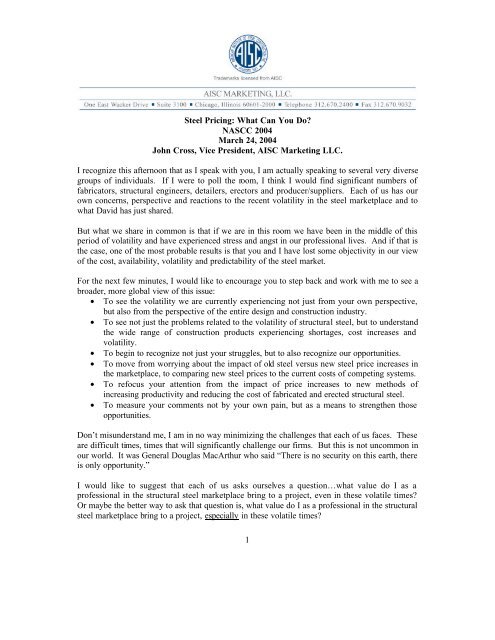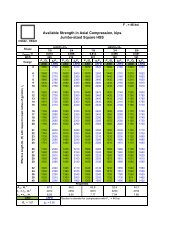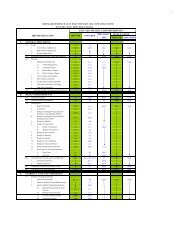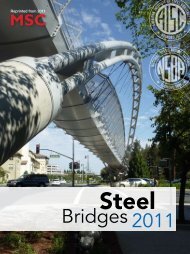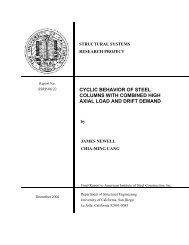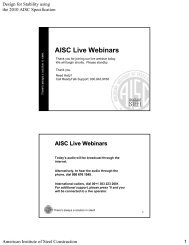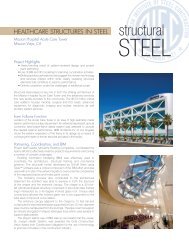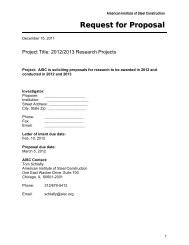Steel Pricing NASCC - AISC
Steel Pricing NASCC - AISC
Steel Pricing NASCC - AISC
Create successful ePaper yourself
Turn your PDF publications into a flip-book with our unique Google optimized e-Paper software.
<strong>Steel</strong> <strong>Pricing</strong>: What Can You Do?<strong>NASCC</strong> 2004March 24, 2004John Cross, Vice President, <strong>AISC</strong> Marketing LLC.I recognize this afternoon that as I speak with you, I am actually speaking to several very diversegroups of individuals. If I were to poll the room, I think I would find significant numbers offabricators, structural engineers, detailers, erectors and producer/suppliers. Each of us has ourown concerns, perspective and reactions to the recent volatility in the steel marketplace and towhat David has just shared.But what we share in common is that if we are in this room we have been in the middle of thisperiod of volatility and have experienced stress and angst in our professional lives. And if that isthe case, one of the most probable results is that you and I have lost some objectivity in our viewof the cost, availability, volatility and predictability of the steel market.For the next few minutes, I would like to encourage you to step back and work with me to see abroader, more global view of this issue:• To see the volatility we are currently experiencing not just from your own perspective,but also from the perspective of the entire design and construction industry.• To see not just the problems related to the volatility of structural steel, but to understandthe wide range of construction products experiencing shortages, cost increases andvolatility.• To begin to recognize not just your struggles, but to also recognize our opportunities.• To move from worrying about the impact of old steel versus new steel price increases inthe marketplace, to comparing new steel prices to the current costs of competing systems.• To refocus your attention from the impact of price increases to new methods ofincreasing productivity and reducing the cost of fabricated and erected structural steel.• To measure your comments not by your own pain, but as a means to strengthen thoseopportunities.Don’t misunderstand me, I am in no way minimizing the challenges that each of us faces. Theseare difficult times, times that will significantly challenge our firms. But this is not uncommon inour world. It was General Douglas MacArthur who said “There is no security on this earth, thereis only opportunity.”I would like to suggest that each of us asks ourselves a question…what value do I as aprofessional in the structural steel marketplace bring to a project, even in these volatile times?Or maybe the better way to ask that question is, what value do I as a professional in the structuralsteel marketplace bring to a project, especially in these volatile times?1
Many of the fabricators in this room have participated in one of our Early Involvement seminars.In that seminar we explore and determine that structural steel is not a commodity, but ratherfabricating structural steel is a specialty activity. I even get all the fabricators in the roomrepeating “I am not a commodity subcontractor, I am steel specialty contractor”. Don’t worry, Iam not going to ask you to repeat that after me today.But whether we repeat it or not, there is no better time for a fabricator to demonstrate that valuethan today. The value a steel specialty contractor brings to a project is not rooted in the millmaterial, rather his contribution is the professional expertise through which he brings value to theproject.So what is your answer to my question “what value do I as a professional in the structural steelmarketplace bring to a project, especially in these volatile times?”Let me suggest that the structural steel industry’s answer to that question is:• I bring current, credible information upon which project decisions can be made• I bring creative alternatives for balancing labor and material costs• I understand the supply chain of the structural steel industry and can work with you toacquire the material you need on your project• I bring opportunities through my early project involvement to improve projectcommunication, optimize designs for fabrication and erection, accelerate schedules andenhance project value• I bring the opportunity to reduce project costs through the use of new technologies likeEDI and new delivery methods like design-build and steel teams to more than offsetrecent increases in material costs• I bring the ability to compare costs of alternative approaches in a confusing marketplace• I bring the benefits of tighter tolerances for enhanced project control to keep other tradesexperiencing cost increase on their original schedules• I bring professionalism and quality to a projectand those are just a few…But those are not the messages that are reaching the design and construction marketplace. Whatthe marketplace is hearing today is that they can’t get steel, steel prices are up, there is a shortageof steel.• The marketplace doesn’t understand the differences between plate, roll, reinforcing bar,strand or structural shape.• The marketplace doesn’t equate an increase in steel prices to an increase in concreteprices, an increase in piping costs, an increase in sprinkler costs, an increase in HVACcosts or an increase in conduit costs. So decisions are made based on mistakeninformation.• The marketplace is making project decisions based on comparing old steel prices to newsteel prices, not on current project pricing of steel framed projects to current projectpricing of concrete framed projects.• The marketplace is looking at material first costs rather total life-cycle project costcomparisons that should include initial framing costs, secondary savings based on systemselection, savings from accelerated schedules in general conditions and equipment rentalsand soft cost savings generated from early occupancy.2
At <strong>AISC</strong> we are working hard to send a positive message into a confused design and constructioncommunity. What is that message? It is a response to the primary concerns of owners, generalcontractors and construction managers who are asking:• What is the impact of increased structural steel prices on my project?• What is the impact of the current volatility on the availability of structural steel for myproject?• How can you help me navigate any surprises that await me as I move forward on myproject?So how do we (and I mean both those of us at <strong>AISC</strong> and each of you) answer those questions?The first question to answer is “What is the impact of increased structural steel prices on myproject”The cost of the project will increase. But, it should be recognized that increases in the mill priceof steel have only a small impact on the overall cost of the project. On a typical project, the costof the fabricated and erected steel frame represents 10% to 12% of the overall project cost. Ofthat steel frame package, mill material accounts for only 20% to 25% of the cost. This meansthat mill material accounts for only 2% to 3% of the project cost. A 40% increase in mill costwould equate to an increase of one percent in project cost.At the same time it is necessary to recognize that many facets of a construction project are alsoundergoing significant cost increases. Concrete prices are up as a result of increases in rebarpricing, serious availability problems relating to post-tensioning strand and plywood formingcosts, HVAC costs have increased as the cost of sheet metal has increased, the electrical tradesare concerned about conduit pricing and the plumbers see their pipe costs rapidly escalating.Project cost increases cannot be laid solely at the feet of the structural steel industry and theymost certainly cannot be brought under control by simply shifting to a different framing system.It is not just the cost of the framing system on a project that should be compared – to fullyappreciate the impact of the selection of steel frame the savings in foundation costs due to alighter structure and general condition savings, equipment rental reductions and constructionloan savings due to accelerated schedules should be taken into account.Our regional engineers, who are our front line in this battle, are consistently experiencing projectowners, general contractors and architects who are stepping back to review their costing numberson projects already designed in steel to see if a concrete solution would be more cost effective.What they are discovering is that structural steel remains the market leader for optimizing andreducing the cost of a project. In many cases, the cost increases for competing materials areresulting in a greater impact on project cost than the increases for structural steel.Historically, if you examine Bureau of Labor statistics since 1980 you will find that the cost ofready mix concrete has increased by 52% while the average cost of structural steel has onlyincreased by 21%.Does this mean that our message to every owner, contractor and architect should be that concretepricing is up more than steel pricing and that they should just pay the new prices and be quiet?3
No! A blanket statement like that has no credibility in the marketplace. <strong>AISC</strong> cannot and doesnot speak for the price of concrete systems just as we hope the concrete industry does not attemptto speak to the price of steel solutions. The message that you and I need to send to owners,architects and general contractors is that if they are reevaluating their projects, they must do socarefully comparing not old prices to new prices, but the current costs on a project level foralternative systems. And to do that it is wise to involve a fabricator, a steel specialty contractor,early in the process for the most accurate information and value generating suggestions.Our conclusion – steel has been and will continue to the most economical framing systemavailable for most projects when looked at from a project wide perspective.The second concern we need to address is “What is the impact of the current volatility on theavailability of structural steel for my project?”Structural steel is in abundant supply from both mills and steel service centers. Domesticdemand for wide flange members in 2004 is projected to be 3.6 million tons against a domesticcapacity of 6 million tons. The construction market in the United States could grow by over 25%and wide flange structural shape would still be readily available. Hear me clearly – the presentvolatility in the market place is not a statement of lack of availability – structural steel is readilyavailable.<strong>Steel</strong> for a project will come from one of two sources – a mill or a service center. An orderplaced by a fabricator for steel that comes directly from a mill is filled either out of inventory orproduced according to a rolling schedule for various shapes. Typically a full rolling scheduleproducing all required shapes takes 6 to 8 weeks to complete. If the demand for a particularshape is high and all of the available tonnage in a given rolling cycle for that shape is reserved,the mills will typically extend the scheduled rolling of that shape in the next cycle to balancesupply and demand.However, it is not necessary to wait until the next time a specific shape is rolled to obtain steel.Service Centers throughout the country stock over one million tons of structural steel for rapiddelivery to your selected fabricator.Hasn’t scrap demand created a shortage of scrap and cut back in structural steel production. No!Domestic mills do not have a shortage of scrap – the cost has risen sharply, but scrap is stillavailable and mill rollings have not been limited.What does that mean to the general contractor, architect or owner?Our conclusion – structural steel is readily available. In fact, the current supply capacity ofstructural steel can absorb a 25% increase in the construction market with no disruption ofsupply.The third concern, “How can you help me navigate any surprises that await me as I moveforward on my project?”This is the question we have been waiting years for owners, general contractors and architects toask. Do you understand that they are asking us, steel professionals, for help? For our expertise?4
For our guidance? That they are looking at us not as a commodity subcontractor, but as a steelspecialty contractor that can bring value into their project?This question is our opportunity to demonstrate the expertise and value a steel professional canbring to a project team.We were asked recently by the Associated General Contractors to answer that question. Weoutlined seven points a general contractor needs to keep in mind. Allow me to share those pointswith you as we presented them…First, recognize today’s situation as an opportunity to develop a better understanding of thespecialty contractor process, particularly that of a steel fabricator. What we all learn in thesevolatile times will serve us well in increasing both your profitability and that of the fabricatorwhen stability returns.Second, recognize that during a period of price volatility for any type of product, the shorter theamount of time between accepting bids, selection notification and authorization to proceed thebetter. If you want a fabricator to lock price on a project, be prepared to hear from the fabricatorthat they will need to turn the project from bid submission to mill or service center order in aperiod of days, not weeks or months.Third, make sure that both you and your bidding subcontractors are approaching the globalmarket volatility on a realistic basis. Some fabricators may suggest including "price adjustment"clauses in their contracts. Whether such clauses should be used on individual contracts is anindividual decision that needs to be made on a job-by-job and company-by-company basis. Ifyou decide to use such clauses they should be structured to be as accurate and as fair to allconcerned as possible.Fourth, on existing contracts be aware that there is discussion at the specialty contractor level toseek recovery of unforeseen cost escalations such as surcharges. This is not just an issue withrespect to the structural steel package, but we have heard similar desires from the plumbing,HVAC, concrete and electrical industries. It is clear that these were unforeseen increases thathave created performance difficulties under existing contracts. It would seem prudent to sitdown and discuss the issue of price escalation with both the project owner and the affectedspecialty contractors at the table to come to a workable solution. This is an internationalproblem that has resulted in price displacements throughout the construction industry. It is notreasonable to anticipate that the specialty contractors should bear this burden alone.Fifth, move away from evaluating pricing on a per ton basis. Evaluate the steel package incomparison to other materials on a per square foot basis and, better yet, make sure you comparesystems based on their impact on total project cost including the overall construction package,accelerated schedule savings in general conditions, soft cost savings from early occupancy andlife cycle cost reductions.But in terms of future projects during this time of volatility and beyond, I would like to suggest asixth consideration. I would recommend that you consider integrating specialty contractors andparticularly a certified steel fabricator early into the project team. Fabricators monitor steelpricing on a continuous basis and can recommend value engineering. Design can be directlyinfluenced to take into account fabrication and erection efficiencies. Fabricators can also5


